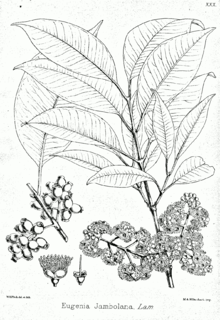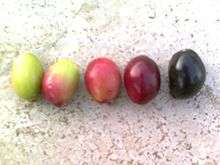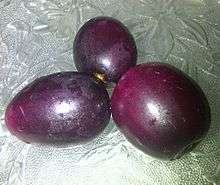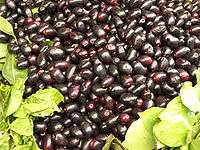Syzygium cumini
| Syzygium cumini | |
|---|---|
 | |
| Scientific classification | |
| Kingdom: | Plantae |
| (unranked): | Angiosperms |
| (unranked): | Eudicots |
| (unranked): | Rosids |
| Order: | Myrtales |
| Family: | Myrtaceae |
| Genus: | Syzygium |
| Species: | S. cumini |
| Binomial name | |
| Syzygium cumini (L.) Skeels. | |
| Synonyms[1] | |
| |
Syzygium cumini, known as jambul, jambolan, jamblang or jamun, is an evergreen tropical tree in the flowering plant family Myrtaceae. Syzygium cumini is native to the Indian Subcontinent and adjoining regions of Southeast Asia. The species ranges across India, Bangladesh, Pakistan, Nepal, Sri Lanka, Malaysia, the Philippines, and Indonesia. The name of the fruit is sometimes mistranslated as blackberry, which is a different fruit in an unrelated family. Syzygium cumini has been spread overseas from India by Indian emigrants and at present is common in former tropical British colonies.[2]
The tree was introduced to Florida, United States in 1911 by the USDA, and is also now commonly grown in Suriname, Guyana and Trinidad and Tobago. In Brazil, where it was introduced from India during Portuguese colonization, it has dispersed spontaneously in the wild in some places, as its fruits are eagerly sought by various native birds such as thrushes, tanagers and the great kiskadee. This species is considered an invasive in Hawaii, United States.[3] It is also illegal to grow, plant or transplant in Sanibel, Florida.[4]
Common names
In English, Syzygium cumini is also known as Java plum,[5] Malabar plum and Portuguese plum. Malabar plum may also refer to other species of Syzygium.
Description
A slow growing species, it can reach heights of up to 30 m and can live more than 100 years. Its dense foliage provides shade and is grown just for its ornamental value. At the base of the tree, the bark is rough and dark grey, becoming lighter grey and smoother higher up. The wood is water resistant. Because of this it is used in railway sleepers and to install motors in wells. It is sometimes used to make cheap furniture and village dwellings though it is relatively hard to work on.
The leaves which have an aroma similar to turpentine, are pinkish when young, changing to a leathery, glossy dark green with a yellow midrib as they mature. The leaves are used as food for livestock, as they have good nutritional value.[6]

Syzygium cumini trees start flowering from March to April. The flowers are fragrant and small, about 5 mm in diameter. The fruits develop by May or June and resemble large berries; the fruit of Syzygium species is described as "drupaceous".[7] The fruit is oblong, ovoid. Unripe fruit looks green. As it matures, its color changes to pink, then to shining crimson red and finally to black color. A variant of the tree produces white coloured fruit. The fruit has a combination of sweet, mildly sour and astringent flavour and tends to colour the tongue purple.
Supposed health effects
The seed of the fruit is used in various alternative healing systems like Ayurveda (to control diabetes, for example.[8][9]), Unani and Chinese medicine for digestive ailments.
Wine and vinegar are also made from the fruit. It has a high source in vitamin A and vitamin C.[10][11][12]
Nutrients and phytochemicals
Nutritional information for S. cumini leaves and fruit are detailed here.

Cultural and religious significance
Lord Krishna is also known to have four symbols of the jambu fruit on his right foot as mentioned in the Srimad Bhagavatam commentary (verse 10.30.25), "Sri Rupa Cintamani" and "Ananda Candrika" by Srila Visvanatha Chakravarti Thakura.[13]
Maharashtra
In Maharashtra, S. cumini leaves are used in marriage pandal decorations. There is famous Marathi song "Jambhul pikalya zada khali...". The seeds are used in herbal teas for diabetes.
Andhra Pradesh
Besides the fruits, wood from Neredu tree is used in Andhra Pradesh to make bullock cart wheels and other agricultural equipment.The timber of Neredu is used to construct doors and windows. Hindus use a sizable branch of the tree to inaugurate beginning of marriage preparations and plant it in a place a pandal will be erected. Culturally, beautiful eyes are compared to this fruit. In the great epic of India Mahabharatha Sri Krishnas'[Lord Vishnu] body color is compared to this fruit as well.These are also good for sugar patients.
Tamil Nadu
There is a very famous legend that is associated with Auvaiyar (also Auvayar), a prominent female poet/ethicist/political activist of Sangam period (Tamil literature), and Naval Pazham(Jambu) in Tamil Nadu. Auvaiyar, believing to have achieved everything that is to be achieved, said to have been pondering over her retirement from Tamil literary work while resting under Naval Pazham tree. But she was met with and was wittily jousted by a disguised Lord Murugan (regarded as one of the guardian deities of Tamil language), who later revealed himself and made her realize that there is still a lot more to be done and learnt. Following this awakening, Auvaiyar is believed to have undertaken a fresh set of literary works, targeted at children.
Kerala
The fruit is particularly plentiful in Kollam.
Karnataka
The tree is widely used by diabetes patients as it was thought to cure the same. The bears like this fruit. This tree is found everywhere in rural areas of Karnataka.
Gallery
- S. cumini fruits in various stages of ripeness
- A line of S. cumini trees
- Close view of foliage
 Ripe fruits for sale in a HAL market in Bangalore
Ripe fruits for sale in a HAL market in Bangalore
See also
References
- ↑ "Syzygium cumini (L.) Skeels". World Checklist of Selected Plant Families (WCSP). Royal Botanic Gardens, Kew. Retrieved 31 May 2013 – via The Plant List.
- ↑ Syzygium cumini
- ↑ Pacific Island Ecosystems at Risk (PIER), retrieved November 3rd, 2010
- ↑ Go fertilizer free, retrieded September 21st, 2012
- ↑ Eugenia Jambolana: Madagascar, Suzanne Urverg Ratsimamanga. Malagasy Institute of Applied Research (IMRA), Antananarivo, Madagascar. http://tcdc2.undp.org/GSSDAcademy/SIE/Docs/Vol7/Eugenia_Jambolana_Madagascar.pdf
- ↑ The encyclopedia of fruit & nuts, By Jules Janick, Robert E. Paull, p. 552
- ↑ Chen, Jie & Craven, Lyn A., "Syzygium", in Wu, Zhengyi; Raven, Peter H. & Hong, Deyuan, Flora of China (online), eFloras.org, retrieved 2015-08-13
- ↑ Article in The Hindu, retrieved June 23, 2007
- ↑ Tips for Health: Wofome
- ↑ Syzygium Cumini, retrieved November 3rd, 2010
- ↑ TopTropicals plant catalog, retrieved November 3rd, 2010
- ↑ Antioxidant actions and phenolic and vitamin C contents of common Mauritian exotic fruits, by Amitabye Luximon-Ramma1, Theeshan Bahorun1, and Alan Crozier, retrieved November 3rd, 2010
- ↑ Vishvanatha, Cakravarti Thakura (2011). Sarartha-darsini (Bhanu Swami ed.). Sri Vaikunta Enterprises. p. 790. ISBN 978-81-89564-13-1.
External links
| Wikimedia Commons has media related to Syzygium cumini. |